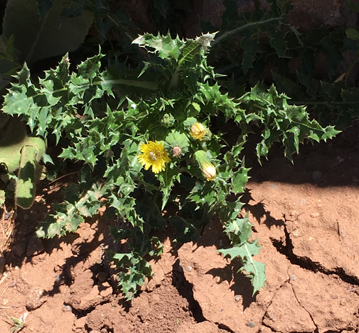
Location
By wall at church (N35D33'00.072 X W105D41'22.392)
Flowers first observed: 5/27/17
The Plant w/Flower

Distribution
"All states --- Roadsides, fields, disturbed ground" (American Southwest)
Description
"Sonchus asper is an annual or biennial herb sometimes reaching a height of 20 cm. with spiny leaves and yellow flowersresembling those of the dandelion. The leaves are bluish-green, simple, lanceolate, with wavy and sometimes lobed margins, covered in spines on both the margins and beneath. The base of the leaf surrounds the stem. The leaves and stems emit a milky sap when cut. One plant will produce several flat-topped arrays of flower heads, each head containing numerous yellow ray flowers but no disc flowers.[5][6]" (Wikipedia)
Ethnobotanical Uses
Food:
"Young leaves have been added to salads or cooked as a hot vegetable (served with butter and seasonings or vinegar) or as a potherb. They are sometimes added directly to curries and rice dishes, but they are usually quite bitter and require at least 1 change of water. Older leaves soon become very bitter and tough." (Kershaw 166)
"---Pima Unspecified Tender leaves rubbed between the palms and eaten raw. Stalks peeled and eaten raw like celery." (Moerman 538)
Medicine:
"In the 13th century, sow thistles was recommended to prolong the virility of gentlemen, perhaps because of its milky sap. It was also believed to increase the flow of milk in nursing mothers. Some herbalists recommend sow thistle for use in salves for healing hemorrhoids, ulcers and other skin irritations and as a bitter and a tonic. The dried sap of annual sow thistle was used to treat opium addiction. Medicinal teas made from perennial sow thistle have been used to calm nerves and to treat asthma, bronchitis and coughs. The leaves were used in poultices and washes for relieving swelling and inflammation, and the milky juice was used to treat inflamed eyes." (Kershaw 166)
"---Navajo, Kayenta Heart Medicine Plant smoked or taken for palpitations. (Moerman 538)
Other Uses:
"The white, milky sap was believed to clear the complexion. It was also dried in balls and chewed like gum. The flowers can be used as a pleasant-tasting ,gummy chew." (Kershaw 166)
Internet Links